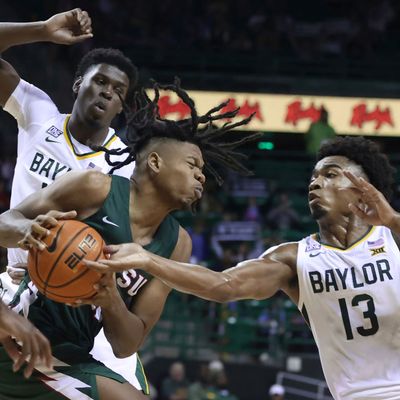
Did you know the men’s and women’s college-basketball seasons started Monday night? They did! According to the irreplaceable college-hoops analytics site KenPom, there were 201 Division I men’s games Monday and 173 women’s games, a full 374 big-time sporting events that you could have attended, watched on television, or wagered on. And I bet you didn’t notice.
That’s totally fine, of course! There’s a lot going on: I’m reliably informed there’s even an election happening Tuesday. But the fact that you (probably) weren’t aware that one of the most popular sports in the United States had started up again speaks to a fundamental truth: Nobody pays attention to college basketball until March Madness starts. Diehards like me — I’m a season ticket holder for men’s and women’s Georgia basketball, and I will be watching my alma mater, Illinois, in six cities this upcoming season — all stayed up late Monday to watch the end of the Rice-Pepperdine game, but none of the rest of you cared.
And nor should you! As professional and collegiate sports have undergone seismic changes over the past 20 years, the NCAA tournament remains a perfect, and perfectly unchanged, experience. It is sports at its purest and simplest: 64 teams (whittled down from 68 after a brief play-in tournament that nobody but Barack Obama and David Cameron pay attention to) in four 16-team regions play a single-elimination tournament over the span of a month. If you win, you keep playing; if you lose, you go home.
The format is so irresistible in part because you don’t even have to follow college basketball to succeed in the office pool; if you just pick your alma mater or the team whose mascot you think is the toughest, you’ve got as much of a chance to win as the experts. And the geographic diversity of the teams makes it easy to forge sudden emotional connections. Last year’s tournament featured teams from Bozeman, Montana; Smithfield, Rhode Island; Hamilton, New York; and Jacksonville, Alabama. You might not be able to name a single college-basketball player, but you know that the obscure college a few miles away is now on the biggest stage and that you’re supposed to cheer against Duke. (That one’s easy to remember.) March Madness is an event that is for everyone during a time when almost nothing else is. It’s no wonder CBS recently paid $8.8 billion for the continued rights to air it. That first tournament weekend might just be the best sports weekend of the year.
Which means, of course, they’re trying to ruin it.
The “they” here are university presidents and athletic directors, who have benefited so much from the incredible moneymaker that is March Madness that they’ve naturally decided to squeeze it until it pops. They have decided to kill, or at least injure, the golden goose.
For those who missed it — and of course you did! There’s no reason to pay attention to college basketball until March! — the power brokers of college sports spent most of the summer and fall vowing to expand the NCAA tournament. At a press conference last month, the league commissioner, Greg Sankey, one of the most powerful people in college athletics and a man who almost always gets what he wants, said he was “open” to the idea of opening the tournament to 96 teams. This was a follow-up to an interview he gave in August, during which he said the tournament needed a “fresh look.” Big Ten commissioner Kevin Warren, probably the second-most powerful person in the sport behind Sankey, said expansion was “something we have to look at.” These were trial balloons that serve as warnings from the people with the actual power to make such changes: Prepare yourself.
Their reasoning is similar to the way late-stage capitalism works in other businesses: They want to maximize their money now. Sankey and Warren run the conferences that — thanks to college football, which is the real behemoth — have become the two most powerful institutions in college athletics largely because they have focused solely on their own interests. If you’re in one of those conferences, you’re gonna get yours, and the rest of the college-sports world has to fight for the scraps. (This dynamic is all a byproduct of a Supreme Court decision that seemed to signal the NCAA’s death blow, which was handed down by Brett Kavanaugh, of all people.)
What Sankey and Warren want is more tournament bids for second-tier college-hoops programs — your Missouris, your Texas A&Ms, your Nebraskas, your Iowas — rather than bids from smaller conferences like St. Peter’s, the glorious upstart from Jersey City that bum-rushed Kentucky and nearly made the Final Four last year. The big conferences have seen the success of those smaller schools, which don’t generate much revenue outside the tournament, and become frustrated: That should be their money, the thinking goes. So they’re trying to expand the tournament not only to theoretically snag more live-television dollars (which is debatable: There will more games, sure, but it’s far from certain they’ll be all that desirable outside the current tournament format) but also to ensure that future teams that make Cinderella runs hail from mainstream conferences, not whatever the MAAC is. It is widely expected that these larger schools will receive better seeds than the small ones, which will be shuffled into play-in brackets and thus will have to win more games just to reach the later levels of the bracket. (Small schools will also be less likely to receive at-large bids than their bigger counterparts.) The goal is to make sure that the teams that play on the grandest stage (the Sweet 16, the Elite Eight, the Final Four) are brand names, not schools nobody’s ever heard of. Expanding the tournament isn’t about expanding opportunity; it’s a land grab. It’s just another way for the richest schools and conferences to claim more territory.
And the cost could be the tournament itself. It’s not just about the loss of symmetry, though it’s worth pointing out just how impossible it would be for your office to figure out an unwieldy 96-team bracket. (Seriously, look at this thing. It’s like trying to sign up for Mastodon.) Worse than that would be the quashing of the underdog, that sense that the people in charge of college basketball see teams like St. Peter’s (or George Mason in 2006 or VCU in 2011) as something to be vanquished as opposed to, you know, the reason people watch the tournament. Only a robber baron would witness what St. Peter’s did last year and think, It would be better if Purdue had done that. Underdogs, and that perfectly designed bracket, are why people love the NCAA tournament. And those in charge are trying to kill both of them.
It isn’t happening this year: We’ll have a normal tournament in March. But all sorts of pieces are being put in motion that could change the tournament format as early as 2024. College basketball today is sustained solely by its tournament. This should be a reason to protect it, not exploit it. Enjoy this season whenever you decide to start paying attention. Because it, like everything else, feels as if it’s approaching the end.
More From This Series
- The NBA Playoffs Are Going to Be So Much Fun
- Thankfully, O.J. Simpson Was One of a Kind
- Jalen Brunson Is the Superstar Knicks Fans Have Been Waiting For






























